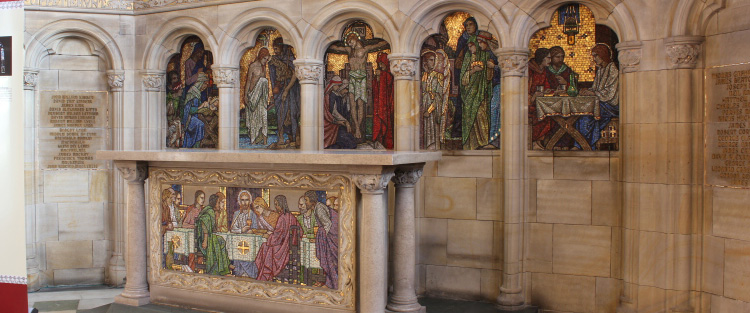The chapel's interior details

Much of what we see today when we enter the chapel is modern, the interior having been stripped of its mediaeval fittings in the Reformation. The surviving sculptural details attest to the church's lost magnificence. Yet despite the Reformers' war on 'graven images' and the work of the 18th-century restorers, the chapel's interior is quite beautiful. This is due largely to the efforts of the architects Peter MacGregor Chalmers and Reginald Fairlie.
The elegant simplicity of Chalmers' memorial to those students who lost their lives in the First World War is deeply moving. The Romanesque blind-arcading and stone communion table are adorned with gorgeous mosaics. Designed by Douglas Strachan, they were realised by the firm of Powell & Sons. The scenes depicted are taken from the New Testament — the rendering of the Last Supper on the communion table being particularly fine.
Stone screens
The stone screen was constructed to Fairlie's designs as a part of the improvements made under Principal Irvine. It is probable that this screen occupies the same site as the original Gothic one. The screen is placed to the east of the south door, creating an ante-chapel two bays wide at the chapel's west end. The design of the screen is Gothic, the twinned trefoil arches echoing the niches of the founder's tomb. The screen supports the wood panelled organ loft, which is decorated with rich, painted carvings. Floral designs alternate with heraldic arms on the face of the loft above the screen whilst the ceiling of the ante-chapel is adorned with ornate bosses. Gold leaf is used throughout to embellish the carvings.
Oak stalls
The oak stalls of the choir are also a product of Fairlie's restoration. These are richly carved with fine pierced decoration in the Gothic style popularised by Sir Robert Lorimer. Carved reliefs of animals and cherubim adorn the woodwork. A photograph taken in the 1960s reveals that as part of Fairlie's original scheme, similar stalls were placed in the organ loft. These appear to have been removed when the new Hradetzky organ was installed in 1974. Fairlie also worked on Kennedy's tomb, adding a bronze front to the founder's tomb-chest. This panel bears a row of saints modelled upon the chapel's surviving Gothic sculpture.
War memorial
The war memorial that occupies the most easterly of the bays of the south wall is another of Fairlie's works. Fairlie's monument to those students lost in the Second World War is a powerful reminder of those who fell. Simple and restrained, the memorial takes the form of a stone tabernacle, carved with the college arms, within which is kept the Book of Remembrance.
Pulpit and ceiling
Unlike so much else within the chapel, the simple wooden pulpit is of considerable age. However, the tradition that links it with the 16th-century Reformer John Knox is unlikely to be true; it is more likely that it dates to the early 17th century. The ceiling also predates the works undertaken this century. Constructed in the early 1860s, it is a dignified, understated affair in dark wood panelling with elegant foliate details highlighted in gold leaf. It forms a fitting crown to the chapel's fine interior.
While it is a tragedy that so little remains of the chapel's original Gothic details, beauty has been restored to the building's interior. The chapel is a harmonious blend of ancient and modern, a product of the sensitive restoration work of gifted artists and craftsmen.